Tavistock, Devon
Up to 1834
A parliamentary report of 1777 recorded parish workhouses in operation at Tavistock (for up to 50 inmates), Lifton (50), and Staverton (30).
Tavistock had a workhouse from around 1741 (Hitchcock, 1985). A site at the west of the town off what is now Maudlins Lane is shown as the "Old Workhouse" on the 1884 map below.
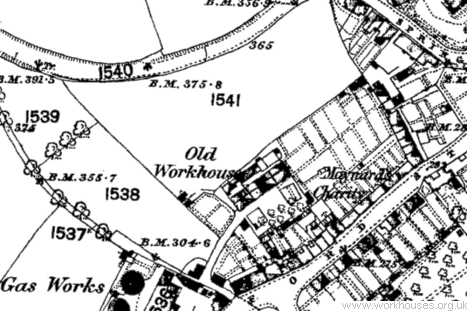
Tavistock Old Workhouse site, 1884.
The old workhouse building has now been converted to residential use.
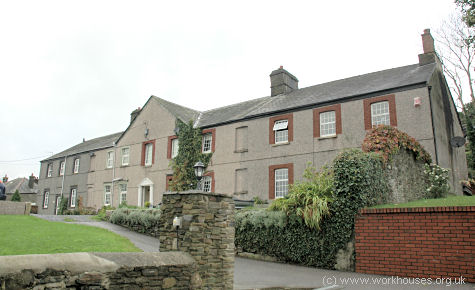
Tavistock former parish workhouse from the south-east, 2005.
© Peter Higginbotham.
After 1834
Tavistock Poor Law Union was formed on 8th October 1836. Its operation was overseen by an elected Board of Guardians, 37 in number, representing its 24 constituent parishes as listed below (figures in brackets indicate numbers of Guardians if more than one):
Devon:
Beer Ferris [Bere Ferrers] (3), Bradstone, Brentor, Buckland Monachorum (2), Coryton, Dunterton, Kelly, Lamerton (2), Lew Trenchard [Lewtrenchard], Lifton (3), Lydford (including Dartmoor), Mary Stow, Mary Tavy [Marytavy] (2), Meavy, Milton Abbott [Abbot] (2), Peter Tavy [Petertavy], Sampford Spiney, Sheepstor, Stowford, Sydenham Damarel [Damerel], Tavistock (5), Thrushelton, Walkhampton, Whitchurch (2).
Later addition: Calstock (Cornwall, from 27 May 1860), Tavistock Hamlets (from 1898).
The population falling within the Union at the 1831 census had been 20,630 — ranging from Brentor (population 147) to Tavistock itself (5,602). The average annual poor-rate expenditure for the period 1834-36 had been £8,547 or 8s.3d. per head of the population.
The Tavistock Union workhouse was built in 1837 at a site on Bannawell Street in Tavistock. It was designed by George Gilbert Scott and his partner William Bonython Moffatt who were also the architects for other Devon workhouses at Bideford, Newton Abbot, and Tiverton. Intended to accommodate 300 inmates, the Poor Law Commissioners authorised the sum of £5,000 on its construction. The workhouse location and layout are shown on the 1905 map below:
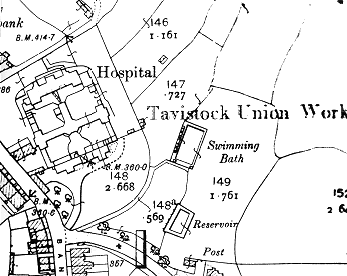
Tavistock site, 1905.
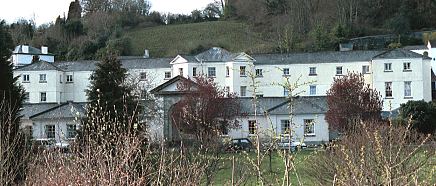
Tavistock general view from the south-east, 2001.
© Peter Higginbotham.
Tavistock followed Scott and Moffatt's typical design. At the south of the site was a single-storey front block with a central entrance archway. This block would probably have contained a porter's lodge, Guardians' board room, clerk's office and so on.
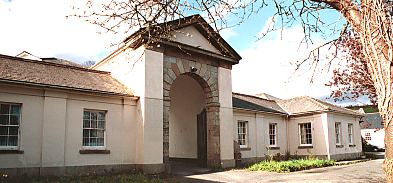
Tavistock entrance block from the south, 2001.
© Peter Higginbotham.
To the rear was the three storey main accommodation block. The master and matron's quarters would have been at the centre, with sections for the different classes of inmates to each side. The area between the entrance and blocks was contained walls to create exercise yards.
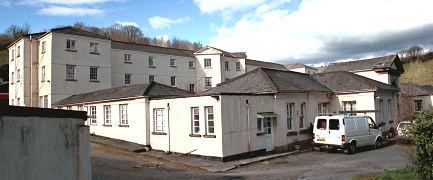
Tavistock lodge and workshops from the north, 2001.
© Peter Higginbotham.
An infirmary block stood at the north of the site.
After 1930, the establishment was taken over by Devonshire County Council and became a Public Assistance Institution later known as Gwynntor Welfare Institution.
The surviving buildings have now been converted to residential use.
Tavistock Children's Homes
The Tavistock Union a home for 24 childreen at 33 West Street, Tavistock.
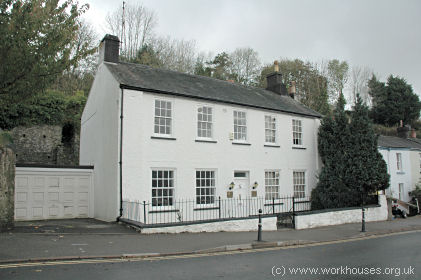
Tavistock West Street children's home, 2005.
© Peter Higginbotham.
A second home at Gunnislake could accommodate 16 children.
Staff
Inmates
Records
Note: many repositories impose a closure period of up to 100 years for records identifying individuals. Before travelling a long distance, always check that the records you want to consult will be available.
- Devon Heritage Centre, Great Moor House, Bittern Road, Sowton Exeter EX2 7NL. Holdings include: Births (1866-1945); Deaths (1866-1919); Creed register (1868-75, 1879-90, 1914-32); Punishment book (1914-48); etc.
Bibliography
- Hitchcock, T.V. (1985) The English workhouse: a study in institutional poor relief in selected counties. l695-l750. (DPhil thesis. University of Oxford.)
Links
- None.
Unless otherwise indicated, this page () is copyright Peter Higginbotham. Contents may not be reproduced without permission.


